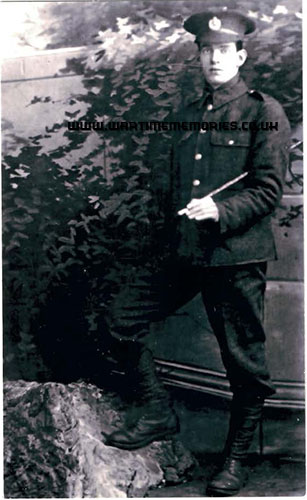Additions will be checked before being published on the website and where possible will be forwarded to the person who submitted the original entries. Your contact details will not be forwarded, but they can send a reply via this messaging system.
please scroll down to send a message
Pte. Martin McMinn
British Army 252nd Tunnelling Coy. Royal Engineers
from:Fife
(d.26th Jul 1916)
Martin McMinn was my great-uncle. He was born in 1890 in Mauchline, Ayrshire, Scotland, the 5th son of my great-grandparents, William and Agnes McMinn. The McMinn family eventually moved to Paisley, Renfrewshire (my hometown). In 1911, Martin was 20-21 years old and had moved to Cowdenbeath, Fife where he become a miner. He was lodging with the West family, where he met Catherine Fraser West, his landlord's daughter, whom he eventually married.
Martin enlisted in Kirkcaldy, Fife, presumably during the British Army's recruitment drive to enlist miners. The desperate need for skilled men saw notices requesting volunteer tunnellers posted in collieries, mineral mines and quarries across South Wales, Scotland, and the northeast of England. He was assigned to the 252nd Tunneling Company of the Royal Engineers. Shortly after the formation of that unit, they were employed in the Hebuterne-Beaumont-Hamel sector of the Somme battlefield. There, the company dug the large mine (code name H3) under the Hawthorn Ridge Redoubt, the German stronghold, ready for the opening battle of the 1st July 1916 and prepared 12 Russian saps facing Serre. Digging the saps required a huge force of labour and by April 1916 the unit had 1,900 infantry attached. Near the Hawthorn Ridge Redoubt, the 252nd Tunnelling Company excavated 3 tunnels under no-man's land.
The first of these tunnels was to link the now famous 'Sunken Lane' (shown in the film, The Battle of the Somme, by cinematographer, Geoffrey Malins, which was shown in cinemas around the UK in August 1916) with the old British front line, through which British units moved into position before the attack. In the early hours of 1st July, the 1st Battalion Lancashire Fusiliers would use this tunnel to move up into the 'Sunken Lane', the starting position for their attack on Beaumont-Hamel. Geoffrey Malins had this to say about the explosion: 'The ground where I stood gave a mighty convulsion. It rocked and swayed. I gripped hold of my tripod to steady myself. Then for all the world like a gigantic sponge, the earth rose high in the air to the height of hundreds of feet. Higher and higher it rose, and with a horrible grinding roar the earth settled back upon itself, leaving in its place a mountain of smoke'.
Martin died of wounds on 26th July 1916 as a result of gas poisoning. He is buried in the Bertrancourt Military Cemetery in the Somme region of France. His widow, Catherine, was awarded a war gratuity of 25 pounds 3s and 4 pence in November 1916 and a further 11 pounds 1 shilling in September 1919.
